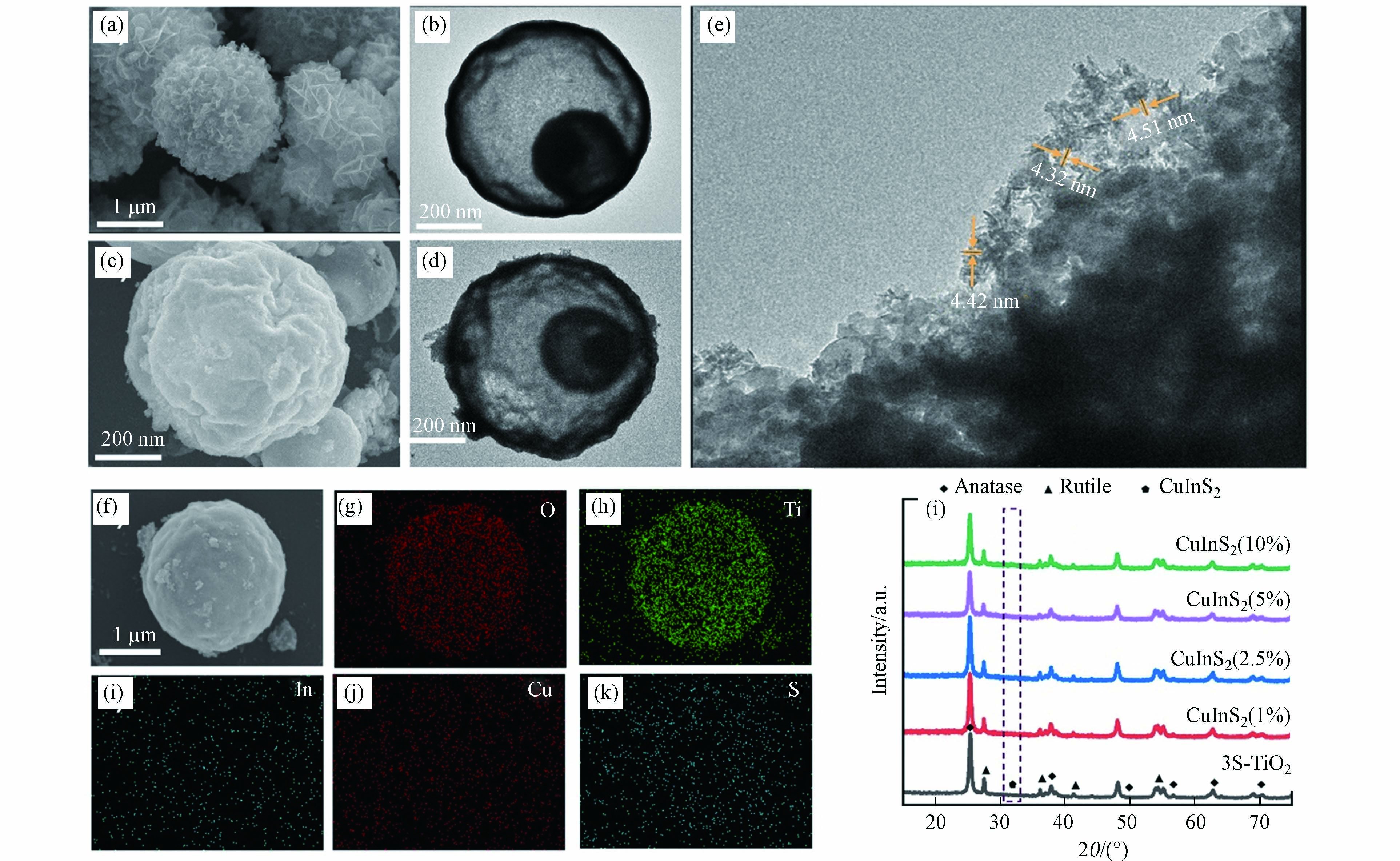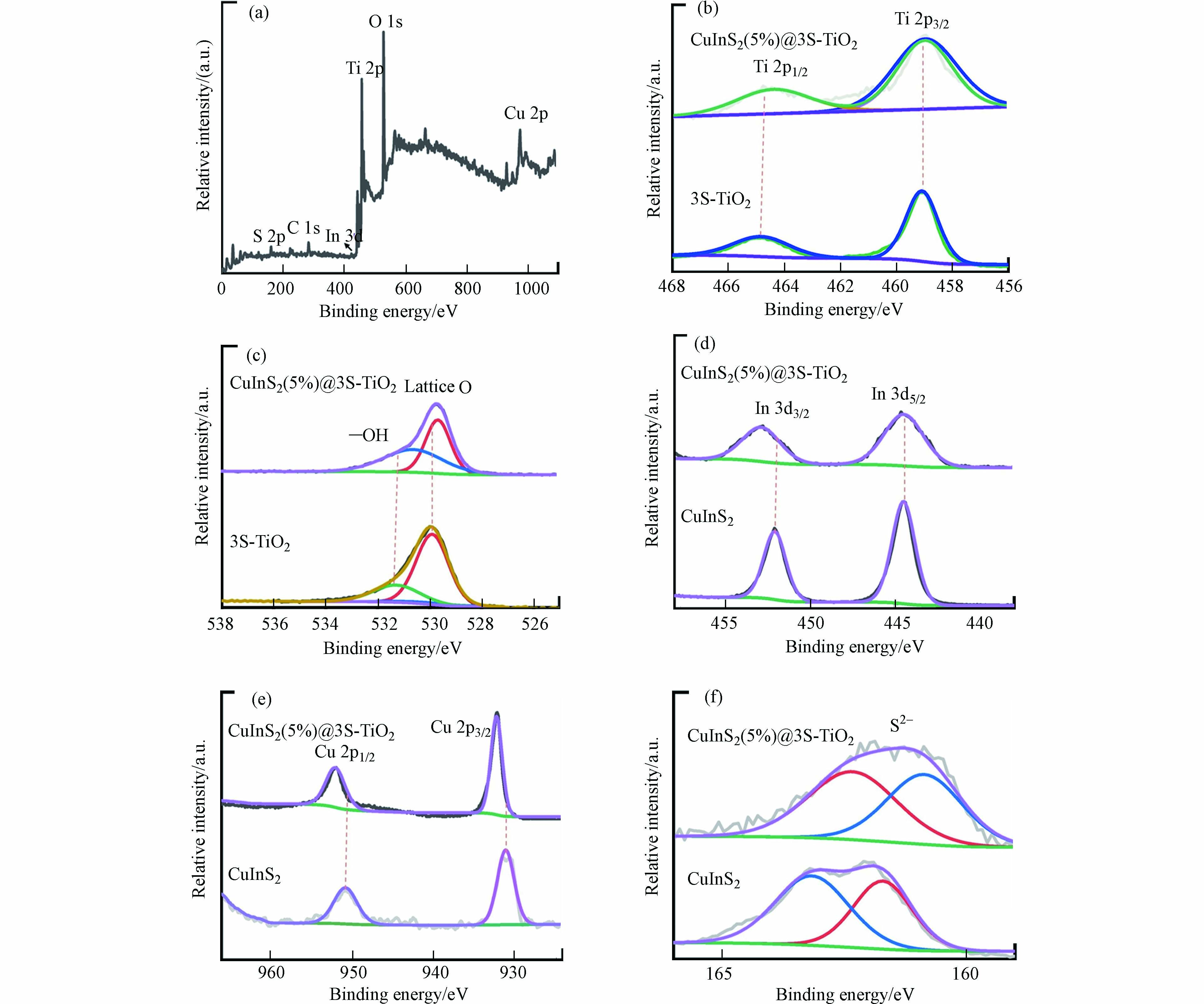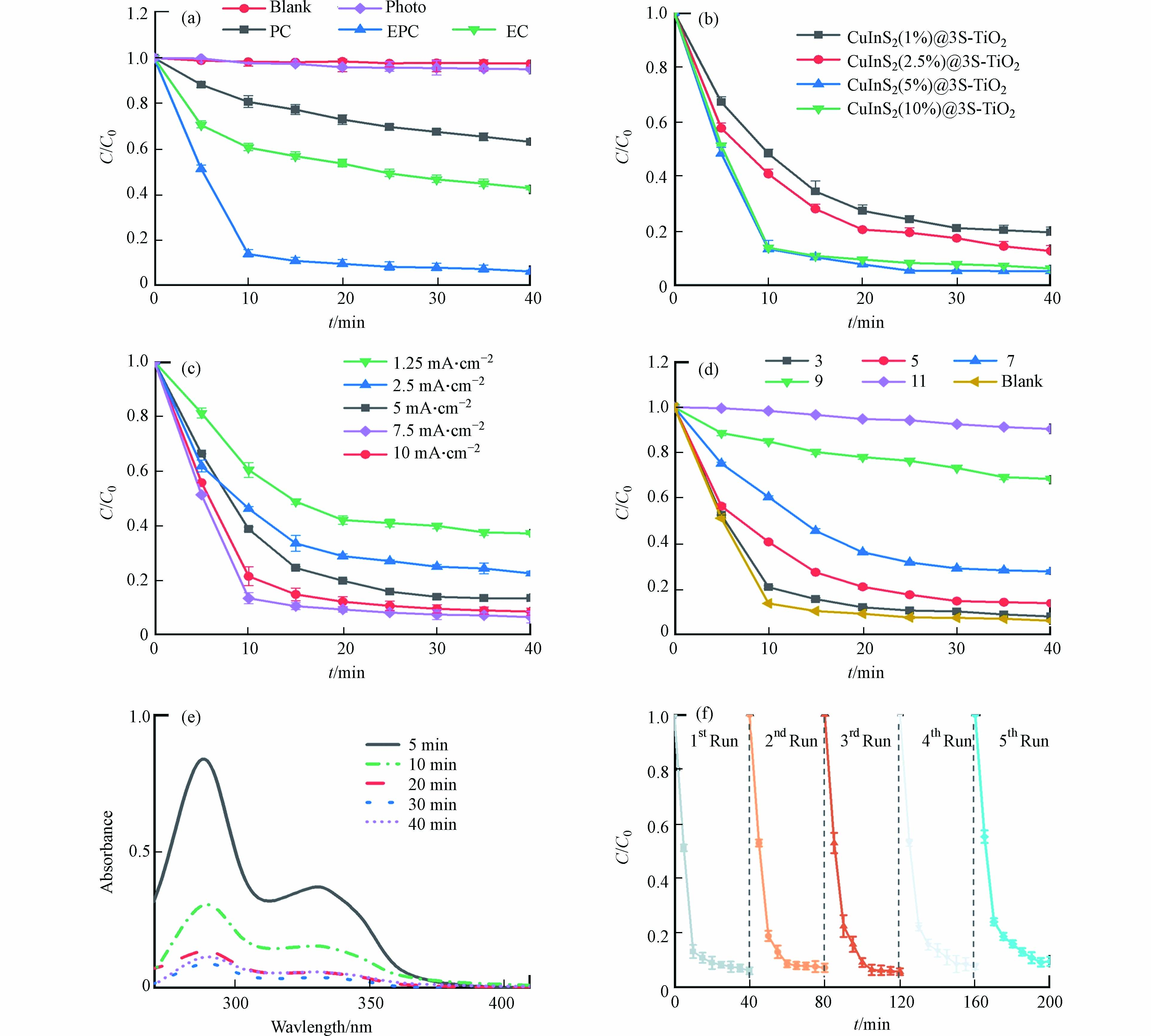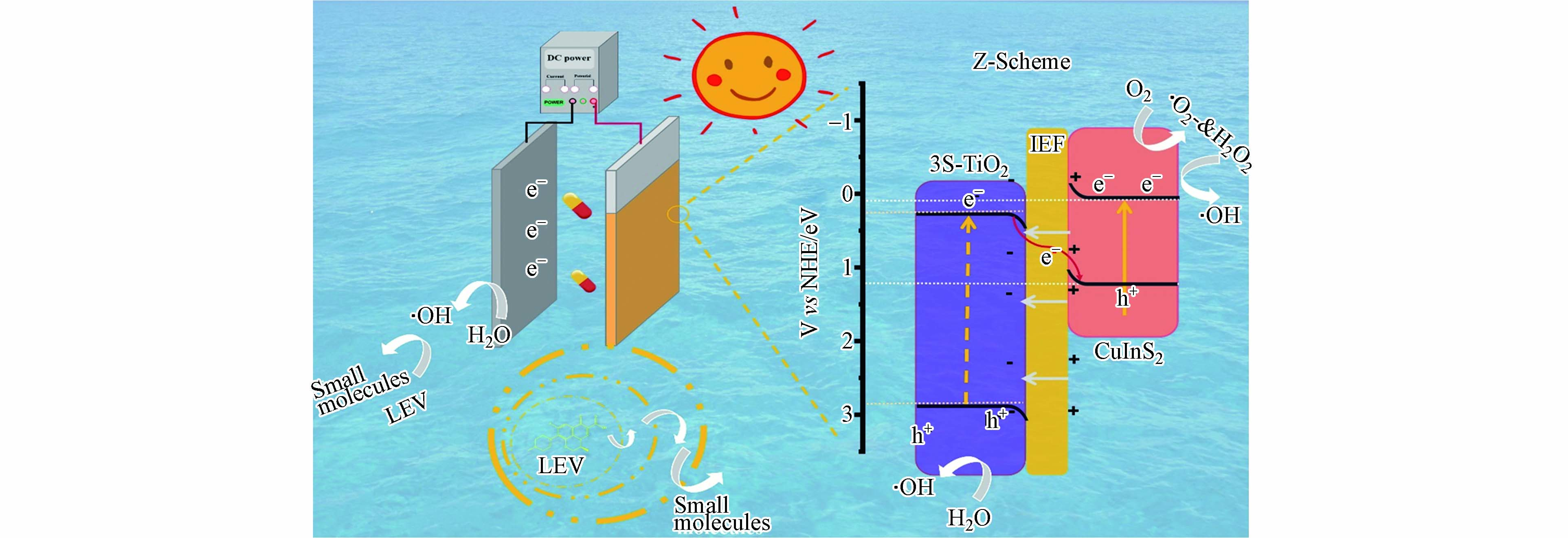-
药物的使用给人类的生产和生活带来了很多便利,但在这种便利的背后,药物过量积累对环境产生了不良影响. 以抗生素类药物为例,其主要来源包括制药产业、农业和人体代谢产物的残留[1-3]. 左氧氟沙星(LEV)是抗生素类药物的典型代表,属于广谱抗菌的氟喹诺酮类药物,常用于治疗呼吸道、泌尿道、皮肤软组织等部位的细菌感染[4]. 然而,左氧氟沙星的不合理使用会造成一系列的不良反应,如神经系统损害、光敏反应、肾脏损伤等. 此外,左氧氟沙星还会对环境造成污染,因为它在人体内的代谢不完全,会随着尿液或粪便排出,进入水体或土壤,对水生生物和农作物产生毒性作用. 因此,寻找有效的方法降解左氧氟沙星,减少其对人体和环境的危害,是一项重要的研究课题. 抗生素的抗菌性使其残留物所污染的水体或土壤难以通过传统的生物方法进行消除[5]. 此外,抗生素对紫外光的吸收能力有限,单独使用紫外光照射进行去除效果并不理想[6].
光电催化是一种利用光照和催化剂同时作用于有机污染物,使其在低于单一电催化的能耗下完成氧化还原反应,从而实现降解或矿化的技术[3, 7-8]. 已证实光电催化是一种有效的处理难生物降解物质的水处理技术,具有广阔的应用前景[9]. 光电催化方法的关键是选择合适的催化剂. 目前,常用的光电催化剂主要是半导体材料,如二氧化钛[7]、锌氧化物、硫化镉等[10]. 这些材料具有较高的光催化活性和稳定性,但也存在一些缺点,如带隙较大,只能利用紫外光;载流子复合速率高,导致光生电子-空穴对无法有效参与反应;表面活性位数量限制反应速率等. 为了解决这些问题,研究者提出了多种优化策略,如掺杂、负载、复合等. 二氧化钛是一种常用的光催化剂,具有良好的化学稳定性、热稳定性、分散性. 但是带隙宽,仅能对紫外光响应[11]. 可以通过掺杂、复合、负载等方法调节其能带结构和表面性质,提高其光催化活性和稳定性,扩大其光响应范围和应用领域[12-13]. 硫铟铜是一种具有层状结构的金属硫属化合物,具有较低的带隙(约1.5 eV)和较宽的光谱响应范围,制备过程简单、无毒性和较高的催化活性[14]. 空心多级结构是一种在光催化领域中大放异彩的新型3D结构[15-16],多级壳层可以提供大量的活性位点和较高的比表面积,增强光催化剂的反应活性和稳定性. 多级空隙可以缓解体积变化和结构应力,防止光催化剂的腐蚀和失活. 较薄的壳层相较于块状材料可以促进光生载流子的分离和传输,提高光利用效率和光催化效率[17-18].
基于此,本文采用次序模板法制备中空三层的二氧化钛作为基底,随后通过水热硫化法将CuInS2负载于3S-TiO2内外表面,形成了一种2D/3D的CuInS2@3S-TiO2复合异质结构. 随后,将上述材料负载于泡沫镍电极上,作为光阳极用于光电催化降解LEV,探讨了CuInS2@3S-TiO2的电子转移路径以及光电催化活性来源.
-
本实验中采用水热法制备碳球模板,作为硬模板中比较特殊的存在,其多孔的结构和负电性易于吸附金属离子,结合次序模板法可以一步制备多层空心结构. 在Wang等过去的研究中,碳质微球是通过蔗糖在水热条件下的乳液聚合反应合成的[19]. 本文最终选择以葡萄糖作为糖源,添加甲醛作为助剂,成功合成单分散碳质微球. 将8 g葡萄糖溶解在25 mL去离子水中并加入1.5 mL HCHO并密封在50 mL的特氟隆内衬不锈钢高压釜反应器内. 随后在200 ℃下反应120 min. 棕色产物用去离子水和乙醇洗涤6 次,并在80 ℃下干燥12 h,研磨并收集产物.
-
在强烈水解的情况下,将84 mL 纯 TiCl4 倒入冰和去离子水的混合物中,形成250 mL的3 mol·L−1 TiCl4 的盐酸溶液. 将0.5 g所制备的碳质微球分散在25 mL 的3 mol·L−1 TiCl4储备液中,超声处理15 min. 将所得悬浮液在搅拌下在50 ℃水浴中老化6 h,然后过滤,用去离子水洗涤一次,并在80 ℃干燥12 h. 将所得复合材料在空气中以10 ℃·min−1的加热速率加热至500 ℃并保持3 h,产生白色粉末状3S-TiO2.
-
水热负载步骤利用1.1.2节所制备的3S-TiO2合成CuInS2/3S-TiO2. 在标准合成中,将3S-TiO2分散在去离子水中,并将悬浮液搅拌10 min. 然后将InCl3·4H2O与CuCl2溶解在溶液中,通过静电相互作用将阳离子Cu2+与In3+吸附在3S-TiO2表面. 搅拌30 min后,加入硫代乙酰胺(TAA)作为硫源并再搅拌15 min. 然后将混合物转移到100 mL特氟隆内衬不锈钢高压釜中,并在180 ℃下处理24 h. 使用乙醇与去离子水分别洗涤3次,通过离心收集产物,并在80 ℃的真空烘箱中干燥12 h. 复合催化剂产物中CuInS2的比例为1%、2.5%、5%、10%和15%. 固定二氧化钛的投加量并按上述比例分别进行铟源与铜源的投料. 其他对照组的合成与此类似,仅改变TiO2的形态.
-
将泡沫镍按顺序浸泡分别浸泡在丙酮、盐酸、乙醇、去离子水中,在超声波清洗器中超声30 min,去除表面杂质,用去离子水清洗后放入60 ℃的烘箱中干燥2 h,蒸发多余水分. 将10 mg的CuInS2@3S-TiO2超声分散在1 mL乙醇中,以3 μL·mg(cat)−1计量的Nafion作为黏结剂. 在红外灯作为热源加热的条件下将催化剂均匀涂覆在泡沫镍上. 获得CuInS2@3S-TiO2/NF作为光阳极以构建光电催化降解系统.
-
采用光辅助的电催化系统,即光电催化降解系统进行实验. 具体的合成路径以及实验装置如图1所示. 本文所使用的氙灯北京中教金源公司生产,氙灯型号为CEL-HXUV300,其发光光谱范围在200—2500 nm. 其色温大于5050 K,色温与太阳温度匹配. 在整个实验周期中均使用型号为7-NP2000-2A的光功率密度仪进行测定,其光功率密度的数值在130—135 mW·cm−2范围内.所使用的阳极基底为泡沫镍电极,阴极为石墨电极. 反应全程通过可控温的水浴锅实现温度恒定.
(1)光电催化性能实验:通过光电催化降解LEV评估CuInS2@3S-TiO2/NF材料的光电催化性能. 电解液为0.1 mol·L−1的Na2SO4溶液,加入10 mg·L−1的LEV. LEV浓度采用紫外-可见吸收光谱法确定. 催化降解的光源与电极之间的距离为5 cm. 在对LEV的降解过程中,以固定的时间间隔(5 min)取样,LEV的浓度用紫外-可见分光光度计(UV-6100 pcs)在289 nm波长下测量. 根据朗伯-比尔定律,LEV的去除率由C0和Ct之间的差值计算,根据以下公式:左氧氟沙星降解效率 = (C0-Ct)/C0 ×100%. 式中,C0和Ct分别为反应前和反应t时刻降解溶液的吸光度值.
(2)猝灭实验是在降解前的溶液中加入猝灭剂,分别使用了草酸铵(AO)、叔丁醇(TBA)和对苯醌(BQ)分别作为h+、·OH和·O2-的猝灭剂,以固定的时间间隔(5 min)取样,用紫外-可见分光光度计测量,计算去除效率.
(3)光电催化稳定性实验:每次测试后将电极使用去离子水与乙醇进行多次洗涤,在真空烘箱中以60 ℃进行烘干. 将同一CuInS2@3S-TiO2/NF电极连续进行5次光电催化活性测试,测试方法同光电催化性能实验.
-
(1)扫描电子显微镜(Scanning electron microscope, SEM)
使用采用场发射扫描电子显微镜(SEM,JSM7800F,日本电子,日本)表征所制备的非均相催化剂表面的形貌. 测试前将制备的催化剂粉末使用乙醇进行分散滴涂在硅片上,利用导电胶固定于载样台上进行测试.
(2)X射线衍射(X-ray diffraction, XRD)
使用型号为Bruke D8 Advance的X射线衍射仪测定电极的晶体结构,具体测试条件为:Cu-Kα为射线源,电压为40 kV,电流为40 mA,扫描速度为10 ℃·min−1,扫描范围10°—80°.
(3)X射线光电子能谱(X-ray photoelectron spectroscopy, XPS)
使用PHI5000 VersaProbe研究反应前后催化剂表面的元素组成,根据反应前后的峰位、峰形、峰强等数据的变化,获得催化剂元素组成和化学价态变化等. 测试前将制备的催化剂表面清洗干净并烘干,裁剪成1 cm×1 cm大小,利用导电胶固定于载样台上进行测试.
(4)电化学性能测试
电化学测试包括电化学阻抗谱(EIS)、瞬态光电流响应曲线(i-t)和莫特-肖特基曲线(Mott-Schottky),在CHI660D电化学站上使用三电极系统在0.1 mol·L−1 Na2SO4电解质中测量. 在三电极系统中,制备的复合材料(2 cm×2 cm)、Ag/AgCl和铂分别用作工作电极、参比电极和对电极. EIS是在开路电压的0.01 Hz至100 kHz的频率范围内测量的. Mott-Schottky是在-1.0—0.1 V的电压范围内测试获得的.
(5)光学性能测试
CuInS2/3S-TiO2的价带XPS(VB XPS)光谱也得到了表征. 样品的紫外-可见光漫反射光谱(DRS)由紫外-可见光-近红外光谱仪(UV3600-MPC3100)收集,以100% BaSO4作为参考.
-
从图2a中可以观察到原始的CuInS2呈现聚集的绣球状分布,整体尺寸约1 μm左右,且硫化物的片状分布均匀. 图2b所示为未经负载的三层二氧化钛中空球,球表面光滑,壳层较薄且每层的界限均较为清晰. 图2c、d分别为CuInS2@3S-TiO2所对应的SEM和TEM图像. 当完成水热负载后,硫铟铜呈较小的簇状且均匀分散[20]. 可以看出,水热负载使得硫铟铜的形貌出现了显著变化,分散性得到了显著提高. 制备的样品中未出现明显的团聚现象.
硫化物的分散性提升为光生载流子的扩散提供了更短的路径[21-22]. 如图2e所示,CuInS2@3S-TiO2上的硫化物形态呈现明显的纳米薄片形态,相较于原始的绣球状[23],薄片尺寸明显从厚度约10 nm减小到约4 nm,这也是后续性能提升的原因之一. 因为其负载比例较低,例如S元素的元素映射并不能突出显示. 通过上述形貌表征证实了CuInS2@3S-TiO2材料的成功合成,且由于二氧化钛基底的存在,硫铟铜的分散性得到了极大的提升,空心多级结构也得到了很好的保持,非常薄的CuInS2纳米片具有较高的比表面积,可以暴露更多的活性位点,这将有利于进行光催化反应. 图2f-k显示了CuInS2@3S-TiO2样品的O、S、Ti、In和Cu的元素映射图. 能观察到Ti与O的均匀分布,其他元素同样如此,但因其负载量低而不够明显. 图2l显示了不同负载量的CuInS2@3S-TiO2样品的XRD图谱. 对于原始的中空三层二氧化钛,衍射峰可以指定为锐钛矿型TiO2(JCPDS 21-1272)与金红石型TiO2(JCPDS 21-1276). 由于CuInS2的负载量很低,在XRD谱图中并没有出现其它衍射峰. 相比之下,负载量较高的10%所对应的样品在32.1°附近出现新的衍射峰,对应于四方CuInS2的(004)平面(JCPDS 85-1575). 上述实验结果共同证实了水热法负载的CuInS2的存在[24].
-
测量紫外-可见漫反射光谱以研究样品的光学吸收特性,如图3所示. 正如预期的那样,原始的TiO2样品只能吸收紫外光(波长约400 nm). 在水热沉积CuInS2后,混合材料显示出随着CuInS2负载的增加而增强的可见光吸收,这是由于CuInS2纳米片的低带隙和强吸收能力造成的[25]. 复合催化剂的光学吸收能力明显提高,有可能导致光催化活性提高[26-27].
-
利用XPS研究了所得样品的表面成分和化学状态. 图4a的XPS总谱显示CuInS2(5%)@3S-TiO2除了Ti和O之外还存在Cu和ln元素,证实了CulnS2的产生. 图4b显示了高分辨率的Ti 2p光谱,其中两个对称的峰为459.1 eV和464.8 eV,分别对应于Ti 2p3/2和Ti 2p1/2. 图4c为两个样品的O1sXPS光谱中,图中的529.2 eV和530.6 eV这两个峰可以分别归属为晶格氧和-OH物种. 值得注意的是,与原始的3S-TiO2相比,复合后的材料所表征得出的Ti 2p和O 1s的结合能均出现了降低,移动了约0.3 eV,这表明复合后的材料中二氧化钛存在来自于CulnS2的电子转移. 这两种材料的组合将在紧密接触的界面处建立内部电场. 在CuInS2(5%)@3S-TiO2的In 3d XPS谱(图4d)中,444.8 eV和452.3 eV的两个强光电子信号分别被分配给In 3d5/2和In 3d3/2. 图4e所示的CuInS2(5%)@3S-TiO2 Cu2pXPS谱图中显示了包含931.0 eV和950.7 eV处的两个信号,分别对应于Cu 2p3/2和Cu 2p1/2. 为了进行比较,还测量了单一CuInS2的XPS. 与CuInS2相比,CuInS2(5%)@3S-TiO2的Cu和In的结合能明显转向更高的值,这意味着电子从CuInS2转移到TiO2,这与上述分析一致,并表明它们之间形成了内置电场. 图4f显示了硫的XPS信号,这可以归因于S2-物种的存在. 显然,S2-来自于CuInS2的形成. 这些结果进一步证明了CuInS2(5%)@3S-TiO2中CuInS2的存在,这与XRD和TEM的分析结果一致[28]
利用XPS研究了所得样品的表面成分和化学状态. 图4a的XPS总谱显示CuInS2(5%)@3S-TiO2除了Ti和O之外还存在Cu和ln元素,证实了CulnS2的产生. 图4b显示了高分辨率的Ti 2p光谱,其中两个对称的峰为459.1 eV和464.8 eV,分别对应于Ti 2p3/2和Ti 2p1/2. 图4c为两个样品的O1sXPS光谱中,图中的529.2 eV和530.6 eV这两个峰可以分别归属为晶格氧和-OH物种. 值得注意的是,与原始的3S-TiO2相比,复合后的材料所表征得出的Ti 2p和O 1s的结合能均出现了降低,移动了约0.3 eV,这表明复合后的材料中二氧化钛存在来自于CulnS2的电子转移. 这两种材料的组合将在紧密接触的界面处建立内部电场. 在CuInS2(5%)@3S-TiO2的In 3d XPS谱(图4d)中,444.8 eV和452.3 eV的两个强光电子信号分别被分配给In 3d5/2和In 3d3/2. 图4e所示的CuInS2(5%)@3S-TiO2 Cu 2pXPS谱图中显示了包含931.0 eV和950.7 eV处的两个信号,分别对应于Cu 2p3/2和Cu 2p1/2. 为了进行比较,还测量了单一CuInS2的XPS. 与CuInS2相比,CuInS2(5%)@3S-TiO2的Cu和In的结合能明显转向更高的值,这意味着电子从CuInS2转移到TiO2,这与上述分析一致,并表明它们之间形成了内置电场. 图4f显示了硫的XPS信号,这可以归因于S2-物种的存在. 显然,S2-来自于CuInS2的形成. 这些结果进一步证明了CuInS2(5%)@3S-TiO2中CuInS2的存在,这与XRD和TEM的分析结果一致[28].
-
图5a展示了3S-TiO2、CuInS2(1%、5%、10%)@3S-TiO2的电化学阻抗谱. 电化学阻抗光谱(EIS)被测量以研究光生电荷转移的动态. 在奈奎斯特图中观察到的半圆对应于样品/电极界面的电荷转移电阻. 一般来说,一个较小的半圆意味着在这个界面上有更好的电荷转移. 可以看出,随着CuInS2含量的增加,半圆变得越来越小,这表明与CuInS2的复合能够改善电子转移,从而导致光催化性能的明显增强. 图5b展示了3S-TiO2、CuInS2(1%、2.5%、5%、10%、15%)@3S-TiO2的瞬时光电流-时间响应曲线(i-t). 可以看出,在光照条件下,复合前后的材料均有光电流响应信号. 且光电流响应的效果随负载比例的增大而先增强后减弱,这与紫外漫反射表征所证实的光吸收范围的扩大以及阻抗的变化规律基本一致. 在10%负载情况下的光电流强度显著高于原始的3S-TiO2以及其他比例负载下的复合材料. 但更大的光生电流有可能带来空穴以及活性物种数量的减少,电流的增加与降解效果并不呈现直接的正相关关系. 为满足更好的降解效果以及绿色化学的要求,本实验仍选择5%负载比例作为最优条件. 上述实验说明3S-TiO2与CuInS2之间异质结的内电场作用促进了光生电子与空穴的有效分离.
-
首先是进行LEV浓度的标准曲线的绘制,分别配置0、2.5、5、10、15、20 mg·L−1的LEV标准溶液,LEV的吸光度用紫外-可见分光光度计在289 nm波长下测量,以最大吸收波长处的吸光度进行浓度-吸光度标准曲线绘制,所得方程作为降解速率评价的标准,标准溶液的吸光度曲线以及标准曲线的绘制如图6所示. 后续性能评价指标以此方程在2所述检测方法的基础上进行重复校验.
为进一步研究光电极的降解性能,在直流电源提供偏压和光照下对浓度为10 mg·L−1的LEV进行降解. 在光电降解之前,先进行30 min暗处理,达到吸附-解吸平衡. 为验证光电催化的协同作用,对CuInS2@3S-TiO2/NF光阳极分别进行了光催化实验(PC)、电催化实验(EC)、光电催化实验(PEC). 为排除多孔泡沫镍的吸附作用以及左氧氟沙星的光降解对性能评估带来的干扰,在未添加外置偏压以及催化剂的条件下进行了吸附实验以及单一光照实验. 结果如图7a所示. 泡沫镍的吸附效果并没有对吸光度的结果产生明显干扰. 在模拟太阳光的照射下,LEV没有出现明显的降解,这也说明LEV本身较为稳定[29]. 可以观察到单纯的电催化方法在40 min后降解率也只达到了57.2%, 催化方法能耗较高且效果并不理想[30]. 单一的光催化表现出优良的降解效率,仅施加光照与催化剂粉末的投加即实现了约37%的降解效率[29]. 在施加了光照和电压的光电催化则是在40 min后达到了93.7%,远高于单一的光催化和电催化[31]. 结果表明,适当的外加电压可以起到辅助光催化的效果,光电协同效应有利于催化降解LEV,结合合理的催化剂能达到更高的降解效率. 图7b显示了不同负载比例的复合催化剂的降解速率曲线,可以观察到随着比例的增加,降解效率存在明显提升,且5%与10%负载比例所实现的效果相近,这与前文所述相关的光电表征所得到的结果一致. 通过控制电源,研究了不同电流密度对LEV光电催化降解效率的影响. LEV初始浓度为10 mg·L−1,溶液pH为自然pH(约5.5),电流密度分别为1.25、2.5、5、7.5、10 mA·cm−2. 由于外电压的升高,可以促进光阳极上光生电子和空穴的分离,使更多的h+参加反应,也可以使更多的e-转移到阴极参与反应,从而产生更多的强氧化性物质,提高降解效率. 通过H2SO4和NaOH调节酸碱度,研究不同pH对催化降解效率的影响. 其他条件一致的情况下,表现出明显的差异. 在偏酸性的条件下,降解效果会略优于中性和碱性条件,与同类研究一致. 而酸性条件下可以提升污染物在材料上的吸附能力[32]. 此外,在弱酸性条件下抑制了析氧副反应的发生,强酸条件会加剧析氢副反应,适宜的pH条件可以提高污染物对于能量以及活性物种的利用效率[33]. 如图7e显示,CuInS2(5%)@3S-TiO2在7.5 mA·cm−2、未调整pH(5.5)和25 ℃的优化条件下,该系统对LEV的降解效率在40 min内可达到93.7%. 经过5次循环,本实验的光电催化系统仍能保持约91.4%,说明CuInS2@3S-TiO2/NF光电催化降解体系具有良好的稳定性.
-
对CuInS2@3S-TiO2性能来源进行分析,首先是其能带位置. 如图8所示,为所制备CuInS2样品和3S-TiO2的VB-XPS谱图和Mott-Schottky曲线. 从图8可以看到,CuInS2和3S-TiO2的M-S曲线斜率均为正,呈现出典型的n型半导体特征, 由VB-XPS测试获得了其价带信息[21].
有机污染物的光电催化降解通常是由h+、·OH和·O2-等活性自由基的氧化完成. 为了确定所设计的降解体系中所产生的活性物质,在其他条件一致的情况下进行了自由基捕获实验. 分别使用了草酸铵(AO,0.01 mol·L−1)、叔丁醇(TBA,0.01 mol·L−1)和对苯醌(BQ,0.01 mol·L−1)分别作为h+、·OH和·O2-的猝灭剂. 在分别加入上述物质后进行降解实验,可以发现AO的加入极大程度上降低了降解率,这也说明h+是主要的活性物种. ·OH和·O2-同样起到重要作用. 此外,通过两组对照实验证明了其结构带来的优势. 当使用商品催化剂P25代替空心多层的二氧化钛时,降解率从94%降低到77%,使用物理混合代替水热负载更是降低到55%. 如图9所示的两组实验证实了其多级结构以及异质结的形成能极大提升光电催化的性能,这与多级结构的诸多特性密不可分.
根据上述分析,光生电子和空穴由于Z型异质结的转移路径分别积累在CuInS2和TiO2中,图10阐明了可能的电荷-空穴分离机制. 如XU等研究中所证实的那样[14],通过原位XPS测量光照下的结合能时,Ti 2p与O 1s相比于黑暗中,出现了明显的正移;而Cu 2p与In 3d出现负移,这直接证实电子的转移是由Z型异质结驱动的. 此外,根据过去的研究,CuInS2的费米能级高于TiO2,两者形成紧密接触的异质结后,电子从具有较高费米能级的半导体转移到费米能级较低的半导体. 这些结论与上述讨论的内置电场进行汇总,可以推测其反应机制. 在光照条件下,CuInS2和TiO2 VB中的电子跃迁到CB,在内置电场的作用下,TiO2 CB中的电子与CuInS2的VB中的空穴结合. 二氧化钛的h+得到保留,而CuInS2中的电子部分又被转移到石墨阴极表面. 如下式(1—6)所述,TiO2中的h+、CuInS2中的电子、阴极表面的电子都参与了LEV的降解过程[28, 34-36].
-
综上所述,新型的CuInS2@3S-TiO2 Z-scheme异质结在PEC过程中实现了光和电的高效协同,并表现出卓越的LEV降解性能. 这种性能提升归因于CuInS2和3S-TiO2之间形成的紧密界面有利于电子传输,多级结构的特殊性质提高了光收集能力,较薄的二氧化钛壳层以及硫化物的薄片降低了电荷传输阻力,并极大增加了吸附面积. Z型异质结的形成促进了e--h+对的有效分离,同时保持了高氧化还原能力,能够产生更多的h+和ROS来降解污染物. 实验探索出了这一系统降解LEV的最优组合并阐明了可能的直接Z-scheme异质结的电子传输机制. 这项工作为构建高性能异质结提出了一种可行的方法,并为制备PEC工艺的实际废水处理中的光阳极提供了一种新的思路.
CuInS2@3S-TiO2复合材料的制备及光电催化降解左氧氟沙星的性能
Preparation of CuInS2@3S-TiO2 composites and performance study of photo-electric catalysis degradation of levofloxacin
-
摘要: 近年来,研究与开发高效实用的新型污水处理技术,尤其是对难降解有毒有害污染物进行高效去除的技术,已成为环境领域的科学前沿和热点问题. 光电催化技术作为一种新兴的高级氧化技术,具有反应条件温和、可利用太阳光、适用性广、无二次污染等优点,在污水处理领域具有广阔的应用前景. 光电催化的核心在于催化剂的设计,而中空多级材料是一种在光催化领域极具前景的特殊结构. 本文通过采用次序模板法合成了不同层数的中空多壳层二氧化钛,并利用水热法修饰并制备了不同比例的CuInS2@3S-TiO2的Z型异质结构复合催化剂. 通过构建光阳极主导的光电催化系统降解左氧氟沙星(LEV),并对系列降解参数进行了优化,同时探究了系统的降解机理. 通过XPS、Mott-Schottky等测试,验证了电子的转移路径,并证实CuInS2@3S-TiO2所组成的异质结构可以扩展光吸收范围、提升光电流密度、促进光生电子和空穴的分离. 此外,光电极在实际使用中也表现出良好的循环稳定性. 通过猝灭实验证明了其活性物质种类及其优势活性物种,并通过一系列对照实验证实了结构所带来的优势以及系统设计的合理性. 通过以上实验证实结构工程与异质结的组合设计实现了对降解效率与矿化效率的调控,并对空间界面上实现级联可能存在的催化机制进行了探讨. 结果显示,CuInS2(5%)@3S-TiO2在7.5 mA·cm−2、未调整pH(5.5)和25 ℃的优化条件下,该系统对LEV的降解效率在40 min内可达到93.7%.Abstract: Research and development of efficient and practical new wastewater treatment technologies, particularly for the efficient removal of persistent toxic and hazardous pollutants, has become a cutting-edge and high-priority issue in the field of environmental science. Photocatalysis, as an emerging advanced oxidation technology, offers advantages such as mild reaction conditions, utilization of solar energy, wide applicability, and absence of secondary pollution, making it highly promising for wastewater treatment applications. The key to photocatalysis lies in catalyst design, and hollow multistage materials represent a special structure with great potential in the field of photocatalysis. In this study, hollow multishell layers of titanium dioxide with varying numbers of layers were synthesized using a sequential template method, and Z-scheme heterostructured composite catalysts with different CuInS2@3S-TiO2 ratios were modified and prepared using a hydrothermal method. A photocatalytic system dominated by the photoanode was constructed for the degradation of levofloxacin (LEV), and a series of degradation parameters were optimized to investigate the degradation mechanism of the system. Experimental results confirmed the pathways of electron transfer through XPS, Mott-Schottky, and other tests. It was also confirmed that the heterostructure composed of CuInS2@3S-TiO2 extended the light absorption range, enhanced the photocurrent density, and promoted the separation of photogenerated electrons and holes. The photovoltaic electrodes also demonstrated good cycling stability during practical use. Quenching experiments confirmed the active substance species and dominant active species. Control experiments further confirmed the advantages of the structure and the rationality of the system design. The combination of structural engineering and heterojunction design in this study achieved regulation of both degradation efficiency and mineralization efficiency. Additionally, the possible catalytic mechanisms for achieving cascade reactions at the spatial interface were explored. The results showed that the degradation efficiency of LEV by CuInS2(5%)@3S-TiO2 could reach 93.7% within 40 minutes under the optimized conditions of 7.5 mA·cm−2, unadjusted pH (5.5), and 25 ℃.
-

-
图 2 (a)CuInS2的SEM图;(b) 3S-TiO2的SEM图; (c) CuInS2@3S-TiO2的SEM图; (d) CuInS2@3S-TiO2的TEM图; (e) CuInS2@3S-TiO2局部放大的TEM图;(f-k)CuInS2@3S-TiO2的元素映射图;(l)所制备材料的XRD图谱
Figure 2. (a) SEM image of CuInS2; (b) SEM image of 3S-TiO2; (c) SEM image of CuInS2@3S-TiO2; (d) TEM image of CuInS2@3S-TiO2; (e) TEM image of CuInS2@3S-TiO2 with local enlargement; (f-k) elemental mapping of CuInS2@3S-TiO2; (l) XRD pattern of the prepared materials
图 4 (a) CuInS2(5%)@3S-TiO2的XPS光谱;3S-TiO2和CuInS2(5%)@3S-TiO2的(b)Ti 2p和(c)O 1s的XPS光谱;CuInS2和CuInS2(5%)@3S-TiO2的(d) In 3d, (e) Cu 2p和(f) S 2p的XPS光谱
Figure 4. (a) XPS survey spectra of CuInS2(5%)@3S-TiO2; XPS spectra of (b) Ti 2p and (c) O 1s of 3S-TiO2 and CuInS2(5%)@3S-TiO2; XPS spectra of (d) In 3d, (e) Cu 2p and (f) S 2p of CuInS2 and CuInS2(5%)@3S-TiO2.
图 7 (a) 泡沫镍吸附,单纯光照,CuInS2@3S-TiO2/NF光电极在光催化、电催化、光电催化5种实验条件下降解LEV;(b)不同负载比例;(c)不同电流密度;(d)不同pH;条件下的光电催化降解LEV (e)降解40 min过程中的全谱图;(f)循环降解实验
Figure 7. (a) Nickel foam adsorption, light experiments, degradation experiments of CuInS2@3S-TiO2/NF photoelectrodes under photocatalytic, electrocatalytic and photo-electrocatalytic experimental conditions; (b) different loading ratios; (c) different current densities; (d) photo-electrocatalytic degradation of LEV under different pH; conditions; (e) full spectrum during 40 minutes of degradation; (f) cyclic degradation experiments
-
[1] DANNER M C, ROBERTSON A, BEHRENDS V, et al. Antibiotic pollution in surface fresh waters: Occurrence and effects [J]. Science of the Total Environment, 2019, 664: 793-804. doi: 10.1016/j.scitotenv.2019.01.406 [2] 卫承芳, 李佳乐, 孙占学, 等. 水-土壤环境中抗生素污染现状及吸附行为研究进展 [J]. 生态毒理学报, 2022, 17(3): 385-399. WEI C F, LI J L, SUN Z X, et al. Research progress of antibiotic pollution and adsorption behavior in water-soil environment [J]. Asian Journal of Ecotoxicology, 2022, 17(3): 385-399(in Chinese).
[3] SONG R, CHI H B, MA Q L, et al. Highly efficient degradation of persistent pollutants with 3D nanocone TiO2-based photoelectrocatalysis [J]. Journal of the American Chemical Society, 2021, 143(34): 13664-13674. doi: 10.1021/jacs.1c05008 [4] 徐君君, 张熙茹, 杜义平, 等. UV/Cu2O/H2O2耦合强化降解左旋氧氟沙星 [J]. 环境化学, 2021, 40(5): 1342-1351. doi: 10.7524/j.issn.0254-6108.2019121602 XU J J, ZHANG X R, DU Y P, et al. Degradation of levofloxacin by UV/Cu2O/H2O2 [J]. Environmental Chemistry, 2021, 40(5): 1342-1351(in Chinese). doi: 10.7524/j.issn.0254-6108.2019121602
[5] FAN G D, YANG S W, DU B H, et al. Sono-photo hybrid process for the synergistic degradation of levofloxacin by FeVO4/BiVO4: Mechanisms and kinetics [J]. Environmental Research, 2022, 204: 112032. doi: 10.1016/j.envres.2021.112032 [6] LIU X H, LIU Y, LU S Y, et al. Degradation difference of ofloxacin and levofloxacin by UV/H2O2 and UV/PS (persulfate): Efficiency, factors and mechanism [J]. Chemical Engineering Journal, 2020, 385: 123987. doi: 10.1016/j.cej.2019.123987 [7] WU H Z, HU Z Z, LIANG R H, et al. Novel Bi2Sn2O7 quantum dots/TiO2 nanotube arrays S-scheme heterojunction for enhanced photoelectrocatalytic degradation of sulfamethazine [J]. Applied Catalysis B:Environmental, 2023, 321: 122053. doi: 10.1016/j.apcatb.2022.122053 [8] WU S Q, HU Y H. A comprehensive review on catalysts for electrocatalytic and photoelectrocatalytic degradation of antibiotics [J]. Chemical Engineering Journal, 2021, 409: 127739. doi: 10.1016/j.cej.2020.127739 [9] QI Z L, LI G Y, WANG M, et al. Photoelectrocatalytic inactivation mechanism of E. coli DH5α (TET) and synergistic degradation of corresponding antibiotics in water [J]. Water Research, 2022, 215: 118240. doi: 10.1016/j.watres.2022.118240 [10] CHEN Z J, WEI W, CHEN H, et al. Recent advances in waste-derived functional materials for wastewater remediation [J]. Eco-Environment & Health, 2022, 1(2): 86-104. [11] BRILLAS E, GARCIA-SEGURA S. Recent progress of applied TiO2 photoelectrocatalysis for the degradation of organic pollutants in wastewaters [J]. Journal of Environmental Chemical Engineering, 2023, 11(3): 109635. doi: 10.1016/j.jece.2023.109635 [12] ARUN J, NACHIAPPAN S, RANGARAJAN G, et al. Synthesis and application of titanium dioxide photocatalysis for energy, decontamination and viral disinfection: A review [J]. Environmental Chemistry Letters, 2023, 21(1): 339-362. doi: 10.1007/s10311-022-01503-z [13] 李贺希, 陈静飞, 卢聪, 等. 金属纳米团簇-二氧化钛纳米管阵列(MNCs-TNTAs)复合材料研究进展 [J]. 环境化学, 2020, 39(11): 3120-3138. doi: 10.7524/j.issn.0254-6108.2020062809 LI H X, CHEN J F, LU C, et al. Research progress of metal nanoclusters titanium dioxide nanotube array(MNCs-TNTAs) composites [J]. Environmental Chemistry, 2020, 39(11): 3120-3138(in Chinese). doi: 10.7524/j.issn.0254-6108.2020062809
[14] XU F Y, ZHANG J J, ZHU B C, et al. CuInS2 sensitized TiO2 hybrid nanofibers for improved photocatalytic CO2 reduction [J]. Applied Catalysis B:Environmental, 2018, 230: 194-202. doi: 10.1016/j.apcatb.2018.02.042 [15] XIAO M, WANG Z L, LYU M Q, et al. Hollow nanostructures for photocatalysis: Advantages and challenges [J]. Advanced Materials, 2019, 31(38): 1801369. doi: 10.1002/adma.201801369 [16] WANG X J, FENG J, BAI Y C, et al. Synthesis, properties, and applications of hollow micro-/ nanostructures [J]. Chemical Reviews, 2016, 116(18): 10983-11060. doi: 10.1021/acs.chemrev.5b00731 [17] ZHU M Y, CHENG Y K, LUO Q, et al. A review of synthetic approaches to hollow nanostructures [J]. Materials Chemistry Frontiers, 2021, 5(6): 2552-2587. doi: 10.1039/D0QM00879F [18] ZHAO G Q, LONG X, ZOU J, et al. Design of hollow nanostructured photocatalysts for clean energy production [J]. Coordination Chemistry Reviews, 2023, 477: 214953. doi: 10.1016/j.ccr.2022.214953 [19] WEI Y Z, WANG J Y, YU R B, et al. Constructing SrTiO3–TiO2 heterogeneous hollow multi-shelled structures for enhanced solar water splitting [J]. Angewandte Chemie International Edition, 2019, 58(5): 1422-1426. doi: 10.1002/anie.201812364 [20] KANG S Z, YANG Y K, BU W B, et al. TiO2 nanoparticles incorporated with CuInS2 clusters: Preparation and photocatalytic activity for degradation of 4-nitrophenol [J]. Journal of Solid State Chemistry, 2009, 182(11): 2972-2976. doi: 10.1016/j.jssc.2009.08.014 [21] HOU H L, YUAN Y F, CAO S, et al. CuInS2 nanoparticles embedded in mesoporous TiO2 nanofibers for boosted photocatalytic hydrogen production [J]. Journal of Materials Chemistry C, 2020, 8(32): 11001-11007. doi: 10.1039/D0TC02244F [22] HAN M M, CHEN W Y, GUO H J, et al. Pulsed laser deposition of CuInS2 quantum dots on one-dimensional TiO2 nanorod arrays and their photoelectrochemical characteristics [J]. Journal of Power Sources, 2016, 318: 121-127. doi: 10.1016/j.jpowsour.2016.04.011 [23] ZHANG K, ZHANG Y H, ZHANG W J. Ultrathin hexagonal SnS2 nanosheets coupled with tetragonal CuInS2 nanosheets as 2D/2D heterojunction photocatalysts toward high visible-light photocatalytic activity and stability [J]. Catalysis Letters, 2018, 148(7): 1990-2000. doi: 10.1007/s10562-018-2413-5 [24] GAO F, ZHENG Q, ZHANG Y. Stability improvement of perovskite solar cells for application of CuInS2 quantum dot-modified TiO2 nanoarrays [J]. ACS Omega, 2019, 4(2): 3432-3438. doi: 10.1021/acsomega.8b03629 [25] 曾升, 周子文, 胡佳齐, 等. 二维ReS2/TiO2异质结薄膜的制备及其光电催化性能 [J]. 材料科学与工程学报, 2021, 39(5): 731-735. ZENG S, ZHOU Z W, HU J Q, et al. Fabrication and photoeletrochemical properties of 2D-ReS2/TiO2 films [J]. Journal of Materials Science and Engineering, 2021, 39(5): 731-735(in Chinese).
[26] 李坚, 石先阳. CdS/CdMoO4空心微球复合材料的化学沉淀法制备及光催化性能 [J]. 环境化学, 2018, 37(10): 2283-2290. doi: 10.7524/j.issn.0254-6108.2017112006 LI J, SHI X Y. Photocatalytic properties of CdS/CdMoO4 hollow microsphere composites synthesized by chemical precipitation method [J]. Environmental Chemistry, 2018, 37(10): 2283-2290(in Chinese). doi: 10.7524/j.issn.0254-6108.2017112006
[27] 刘顺强, 解明江, 郭学锋, 等. 混晶海胆状TiO2空心球多级结构的制备及其对亚甲基蓝的光催化降解 [J]. 无机化学学报, 2020, 36(2): 317-323. doi: 10.11862/CJIC.2020.037 LIU S Q, XIE M J, GUO X F, et al. Preparation and photocatalytic degradation of methylene blue of hierarchical mixed-phase urchin-like TiO2 hollow spheres [J]. Chinese Journal of Inorganic Chemistry, 2020, 36(2): 317-323(in Chinese). doi: 10.11862/CJIC.2020.037
[28] LI T T, LI X Y, ZHAO Q D, et al. Fabrication of n-type CuInS2 modified TiO2 nanotube arrays heterostructure photoelectrode with enhanced photoelectrocatalytic properties [J]. Applied Catalysis B:Environmental, 2014, 156/157: 362-370. doi: 10.1016/j.apcatb.2014.03.035 [29] ZHAO Y Y, GUO H X, LIU J, et al. Effective photodegradation of rhodamine B and levofloxacin over CQDs modified BiOCl and BiOBr composite: Mechanism and toxicity assessment [J]. Journal of Colloid and Interface Science, 2022, 627: 180-193. doi: 10.1016/j.jcis.2022.07.046 [30] LIU L, ZHOU L L, LIU D, et al. Improved degradation efficiency of levofloxacin by a self-powered electrochemical system with pulsed direct-current [J]. ACS Nano, 2021, 15(3): 5478-5485. doi: 10.1021/acsnano.1c00233 [31] XING Z H, WANG Z J, CHEN W H, et al. Degradation of levofloxacin in wastewater by photoelectric and ultrasonic synergy with TiO2/g-C3N4@AC combined electrode [J]. Journal of Environmental Management, 2023, 330: 117168. doi: 10.1016/j.jenvman.2022.117168 [32] ZHONG X, ZHANG K X, WU D, et al. Enhanced photocatalytic degradation of levofloxacin by Fe-doped BiOCl nanosheets under LED light irradiation [J]. Chemical Engineering Journal, 2020, 383: 123148. doi: 10.1016/j.cej.2019.123148 [33] ZHONG Y W, SHIH K, DIAO Z H, et al. Peroxymonosulfate activation through LED-induced ZnFe2O4 for levofloxacin degradation [J]. Chemical Engineering Journal, 2021, 417: 129225. doi: 10.1016/j.cej.2021.129225 [34] ZENG L B, LI X Y, ZHAO Q D, et al. Boosting interfacial charge transfer and electricity generation for levofloxacin elimination in a self-driven bio-driven photoelectrocatalytic system [J]. Nanoscale, 2019, 11(45): 22042-22053. doi: 10.1039/C9NR05520G [35] CAO T T, XU J J, CHEN M D. Construction of 2D/0D direct Z-scheme Bi4O5I2/Bi3TaO7 heterojunction photocatalysts with enhanced activity for levofloxacin degradation under visible light irradiation [J]. Separation and Purification Technology, 2022, 291: 120896. doi: 10.1016/j.seppur.2022.120896 [36] GAO B W, SUN M X, DING W, et al. Decoration of γ-graphyne on TiO2 nanotube arrays: Improved photoelectrochemical and photoelectrocatalytic properties [J]. Applied Catalysis B: Environmental, 2021, 281: 119492. doi: 10.1016/j.apcatb.2020.119492 -



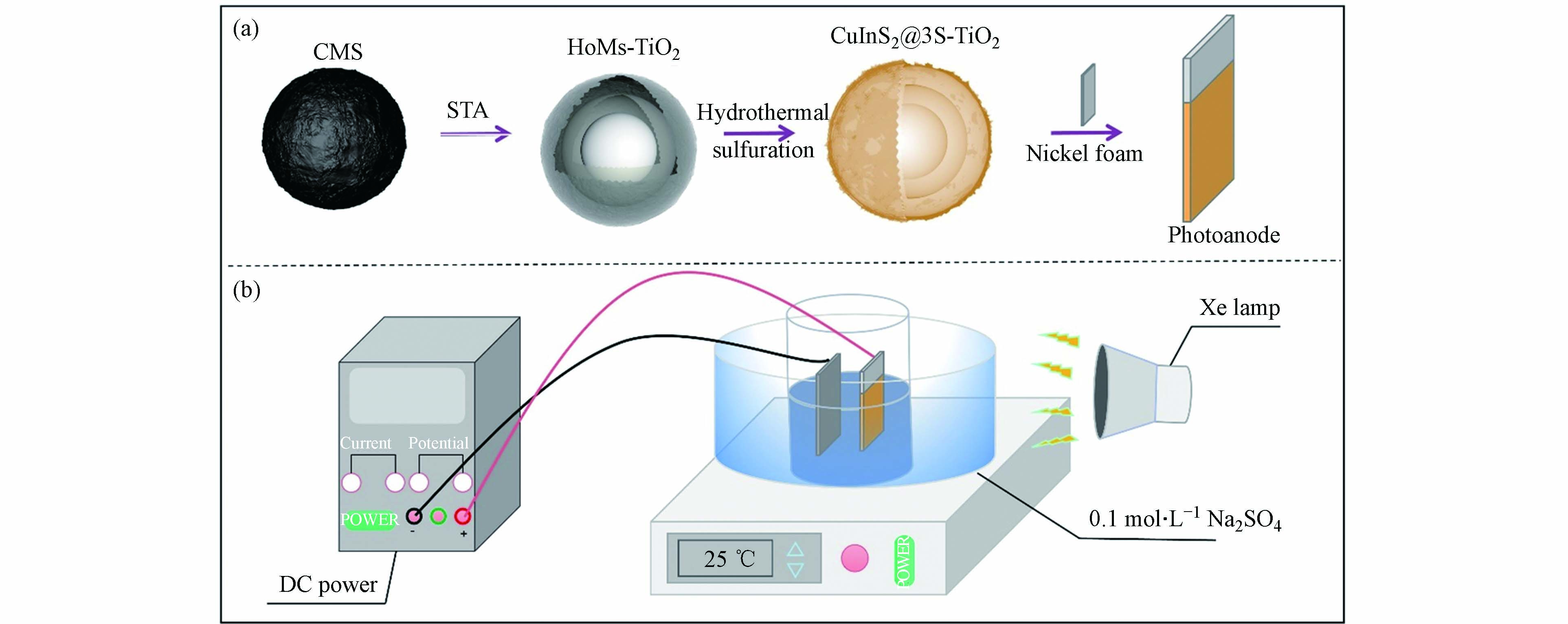
 下载:
下载:
